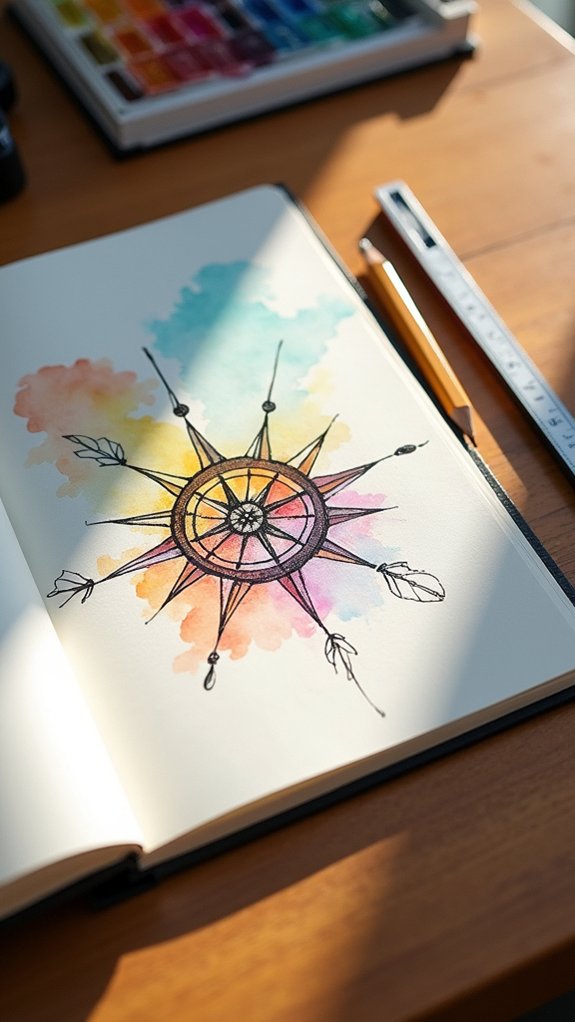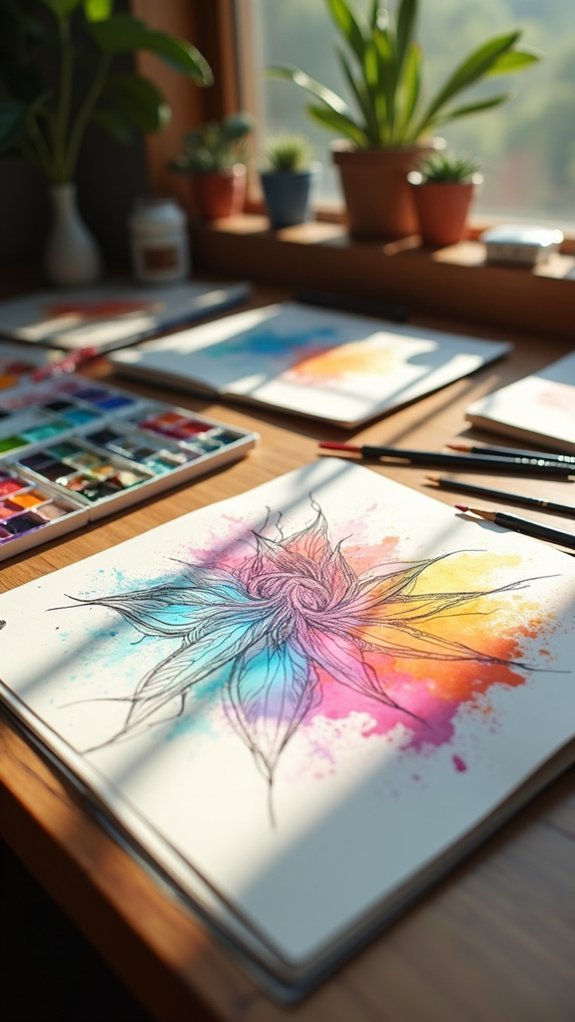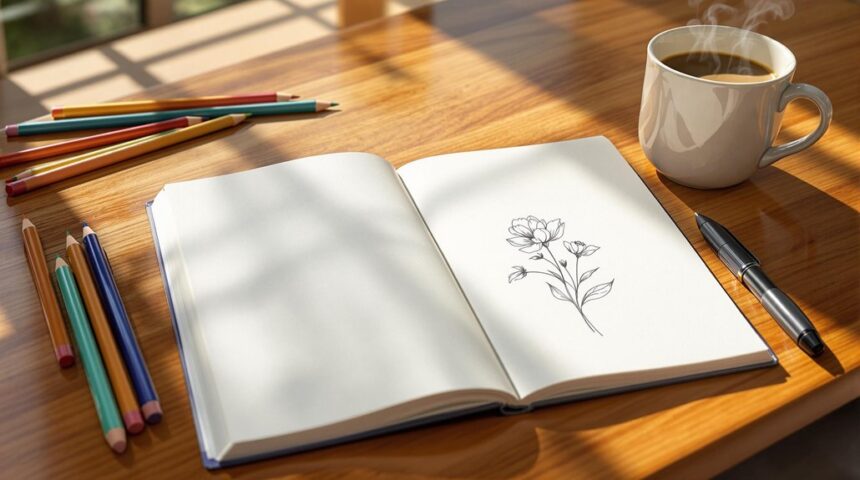Starting a new sketchbook is seriously exciting, and making that first page your own is a big deal. Pick a theme that feels like you—maybe nature, bold patterns, or just your favorite quote in funky lettering. Throw in a mini self-portrait, add splashes of color, cool doodles, or even a goals checklist (because, why not?). Set up a layout that’s fun but won’t make future you cringe. If you’re wondering exactly how to pull these ideas together, you’re in for a real treat next.
Key Takeaways
- Choose a theme or color scheme that reflects your personal style and interests for a meaningful first impression.
- Design an inviting layout by adding frames for your name, sketchbook number, and start date for easy organization.
- Add self-portraits, favorite quotes, or artistic symbols to personalize and inspire creativity each time you open your sketchbook.
- Experiment with different art techniques like watercolors, collages, or doodles to showcase your creativity from the start.
- Set sketchbook goals and include drawing prompts on the first page to keep yourself motivated and focused throughout your art journey.
Choosing a Theme That Reflects Your Style
Finding the perfect theme is like picking the outfit for the grand debut—exciting, a little nerve-wracking, and totally personal. The first page of a sketchbook sets the mood, so it’s important to choose a theme that screams “you.”
Some people immerse themselves in nature vibes, others love going bold with abstract patterns or wild color splashes. Your personality should shine through—maybe with your favorite quote, a symbol that means something special, or art inspired by someone you admire.
Experimenting with artistic techniques, like adding a watercolor wash or creating a mini collage, gives that extra magic. The right color scheme—whether super bright or soft and chill—lets your style pop.
In the end, the best first page is one that’s as unique as you are.
Designing an Inviting and Functional Layout

Excitement buzzes when someone opens their sketchbook to a first page that feels both welcoming and useful—kind of like getting a secret map for a brand-new adventure. Designing an inviting and functional layout means organizing the chaos of ideas. Frames let you jot down details like the sketchbook number or start date, so you never lose track of when you began your journey. Tables are handy for checklists—think “draw every day” or “try five new sketchbook ideas.” Want even more inspiration? Try adding a few drawing prompts on the first page to kickstart creativity. And don’t be afraid to splash in some color with watercolors and markers, making each section pop!
| Section | Purpose |
|---|---|
| Info Frame | Track dates |
| Goal Checklist | Set intentions |
| Drawing Prompts | Spark ideas |
| Color Swatch | Add flair |
Adding Personalized Elements: Self-Portraits and Quotes
A self-portrait splashed across the first page is like planting a flag—this is your territory.
When starting a sketchbook, doodling your own face, in your own style, feels almost like saying hello to your future self. Watercolors can make your self-portrait extra lively—imagine shades swirling together, showing off your personality before you even turn the page.
But don’t stop there! Jot down a motivational quote, maybe “Work smarter not harder,” and give it a clever twist—write it on a drawing of a laptop screen, then color it with bold markers.
Not only does this inspire you whenever you peek inside, it turns your sketchbook’s first page into a pep talk. A quick checklist of goals seals the deal—boom, instant inspiration!
Exploring Artistic Techniques and Materials

Jump right in and let the first page turn into a playground for trying out every art technique that sounds fun.
Maybe you want to splash some color with watercolor techniques, blending two wild shades and letting them dry into something magical. Outlining your favorite markers or colored pencils? Absolutely! Toss in some squiggly lines for good measure—seriously, squiggles instantly crank up the fun.
This is also a great chance to experiment with scrapbook paper, creating tiny pockets on the cover to stash swatches or secret drawing ideas. Love organization? Try a checklist format; it’s awesome for sketchbook goals, plus it looks super neat.
Personal touches, like doodling your art supplies or pasting a mini self-portrait, will make your first page totally unique and inviting.
Setting Sketchbook Goals and Creative Prompts
After the first page bursts with wild experiments and cool materials, there’s something super powerful about setting down real intentions for your sketchbook adventure. A killer way to do this is by creating a checklist of sketchbook goals—like finally mastering hands or drawing every pet you’ve ever wanted. Feeling stuck? Add some drawing prompts right on that page, letting your future self laugh at your own genius ideas or curse your past self’s weird suggestions. A positive quote, such as “Work smarter not harder,” boosts your vibe when art blocks hit hard. Need a quick cheat? Use tracing techniques to draw your favorite supplies. Here’s a table to spark some creative fire:
| Sketchbook Goals | Drawing Prompts | Positive Quote |
|---|---|---|
| Draw every day | Draw your dream pet | “Work smarter not harder” |
| Try a self-portrait | Imagine a new monster | “Create, don’t hesitate” |
| Fill every page | A memory from school | “Art takes courage” |
| Experiment with color | Design your snack | “Mistakes are proof you tried” |
| Explore new supplies | Favorite superhero | “Small steps, big results” |
Frequently Asked Questions
What Should I Write on the First Page of My Sketchbook?
When deciding what to write on the first page, individuals may include creative prompts, personal statements about their artistic journey, motivational quotes, or a checklist of intentions, helping to personalize and inspire their sketchbook experience from the outset.
How to Fill Your Sketchbook for Beginners?
Filling a sketchbook for beginners involves exploring diverse sketchbook themes, utilizing drawing prompts, and engaging in creative exercises. Incorporating favorite tools, experimenting with techniques, and referencing online inspiration all help to nurture artistic growth and maintain motivation.
What Should I Draw on My First Page?
Considering what to draw on a first page, one may select inspirational quotes, personal symbols, and favorite colors. These elements set a welcoming tone, inspire creativity, and reflect the artist’s individuality for the sketchbook’s journey ahead.
How to Make an Easy Sketchbook?
To make an easy sketchbook, one selects simple sketchbook materials like cardstock and recycled paper, binds them with staples, and experiments with foundational drawing techniques. Inspiration sources such as everyday objects or nature can encourage regular artistic practice.
Conclusion
Starting your sketchbook can feel both exciting and nerve-wracking—like staring at a blank page before a big test, only way more fun and way less grading! By picking a theme, designing a fun layout, adding touches of “you,” and trying new materials, any artist can launch their sketchbook journey. Goals and prompts keep things fresh, and hey, mistakes are part of the ride. So, grab those pens and plunge into it—your first masterpiece might be just a doodle away!


Leave a Reply